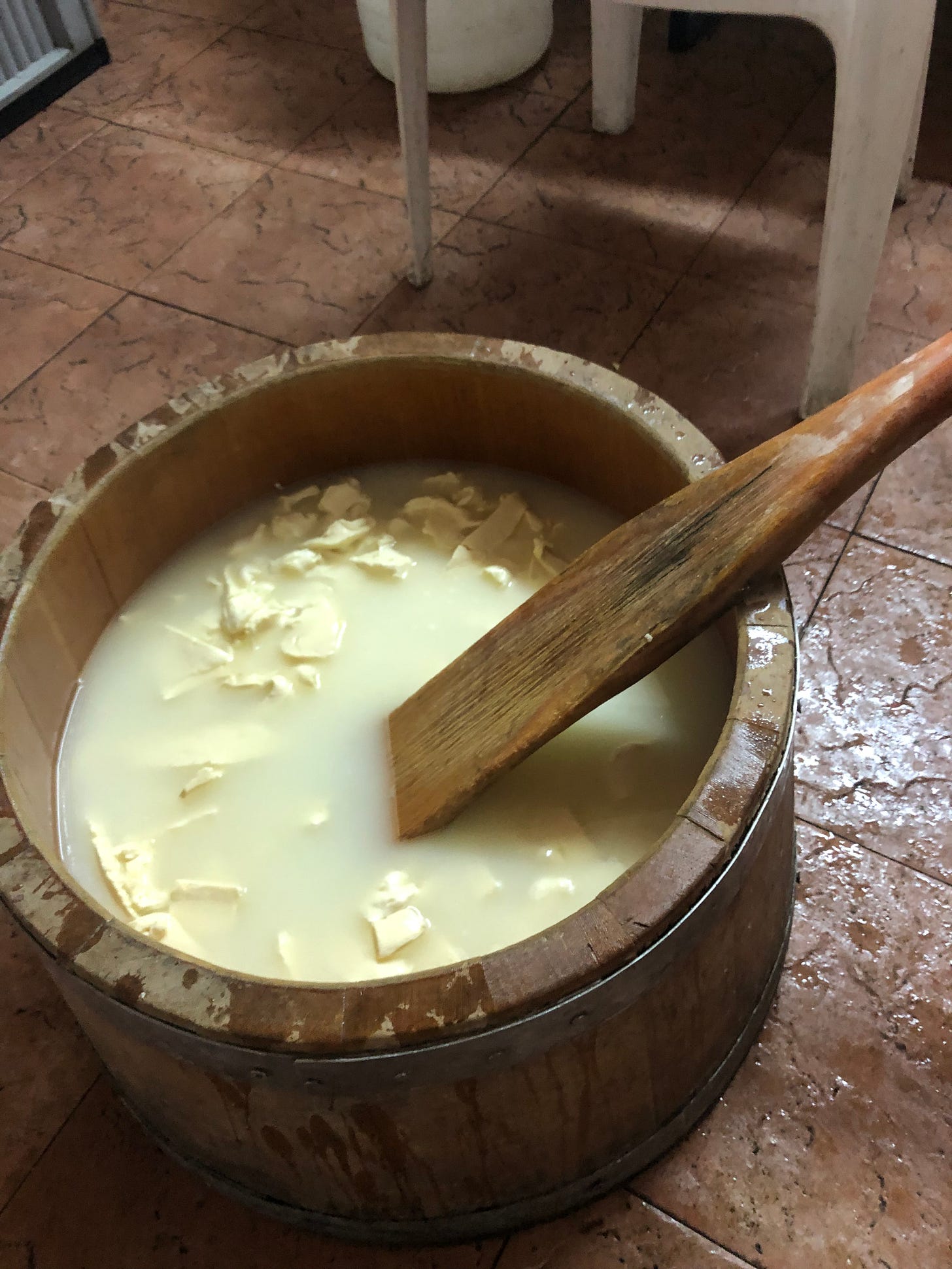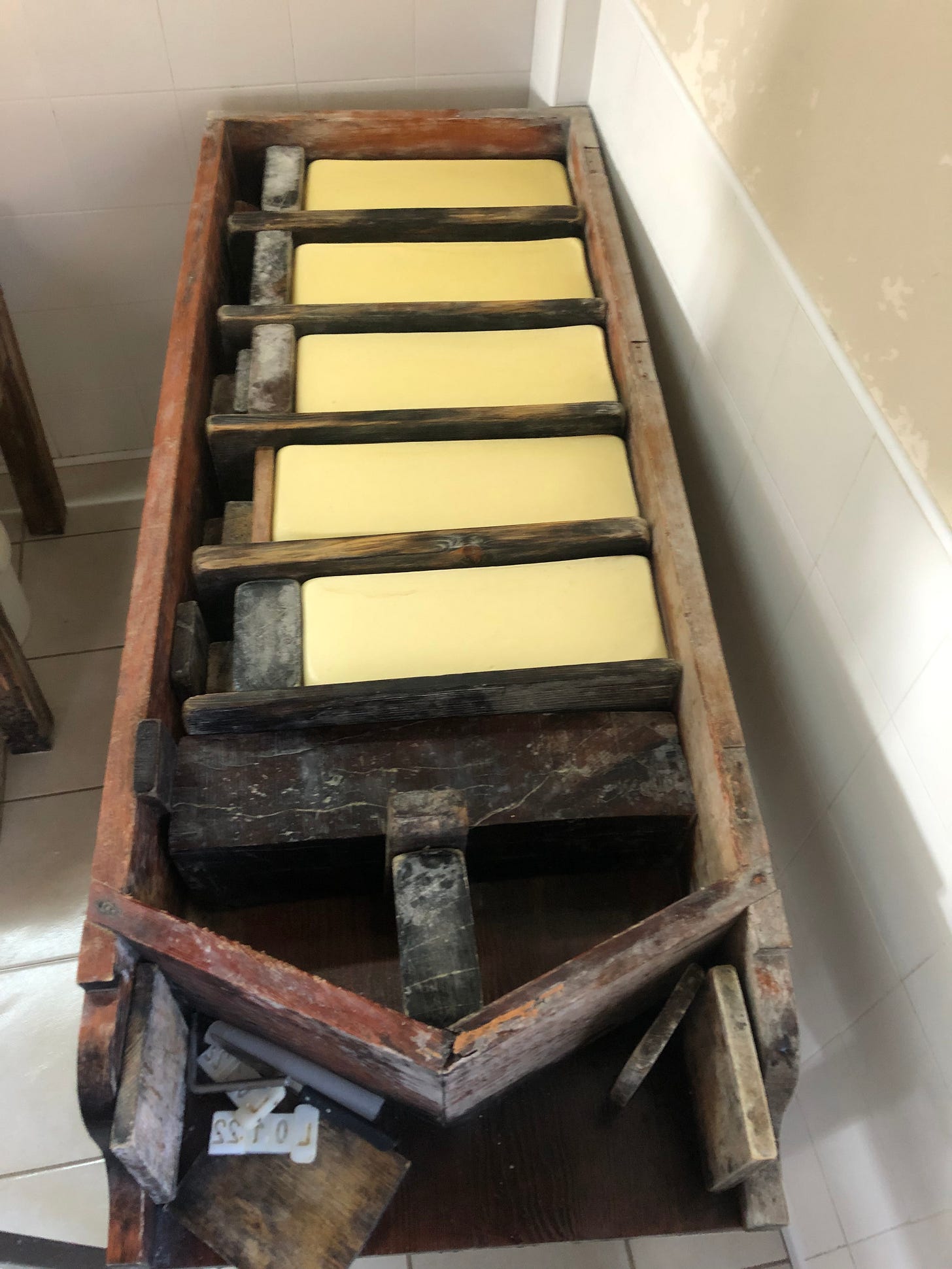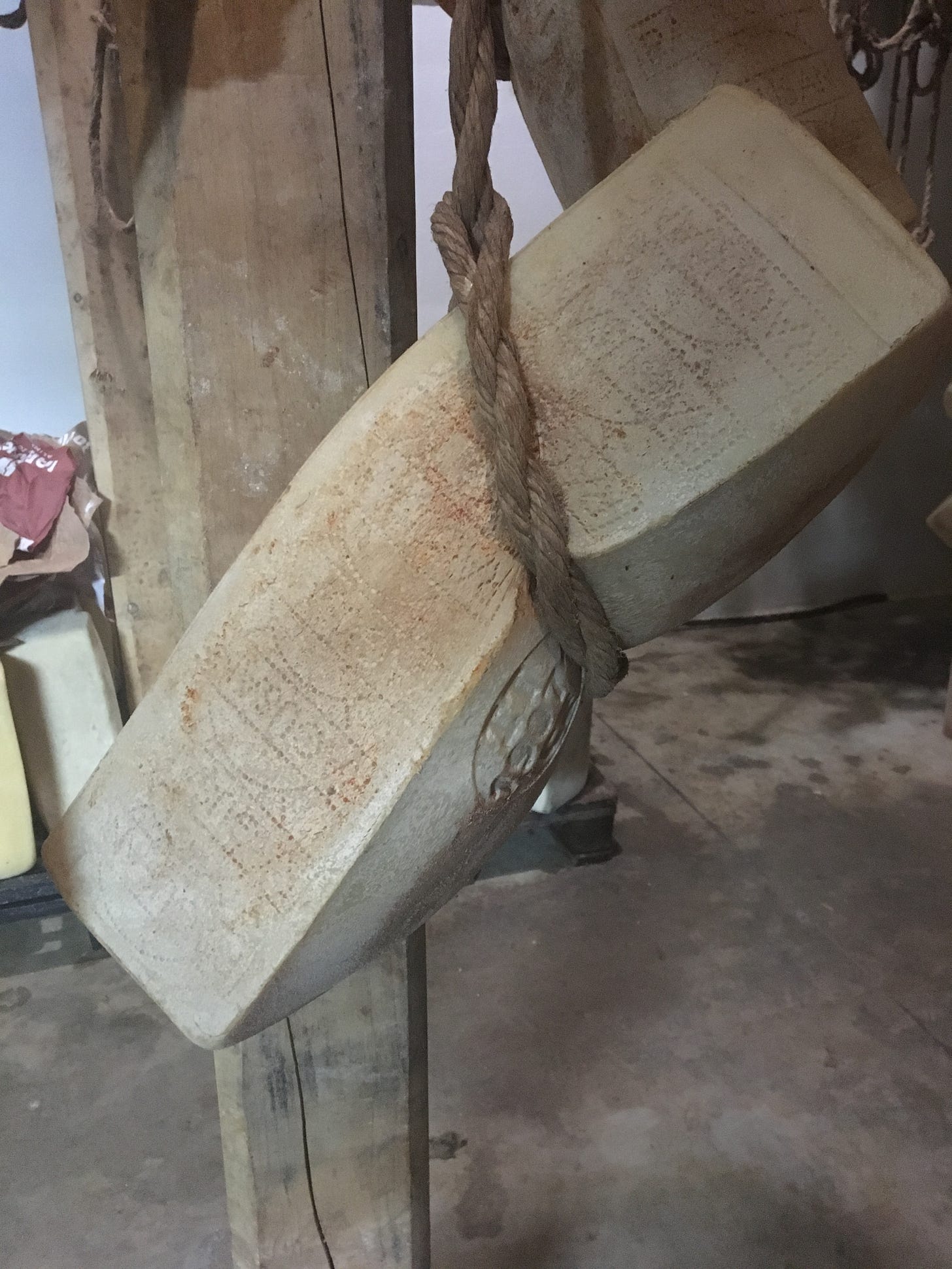Ragusano part 3: The make, tools, and affinage.
The value of a slow fermentation, wooden tools, and a recipe that is lived rather than written.
This builds on my last two posts, and wraps up this piece that was published by The Preserve Journal. I recommend reading part one, and part two first.
Then let me know what you think of article as a whole.
I wrote this about two years ago and feel it is a good representation of the way I like to approach cheese, and the wide angle view that I now share in workshops and other events.
For me, the ultimate cheeses are born from people and places, from pastoral communities and their relationships with livestock, landscapes, and microbes. These foods point past themselves, to ways of living on the earth that are becoming rare, but that the world needs to see now more than ever.
The Make Process and Tools
The Modicana milk has a lamb rennet paste added to induce coagulation. This part of the process always reminds me of a witch brewing potions in a cauldron. The cheese magician adds extracts of an animal’s stomach and stirs in a ritualized way. This stirring is performed with a wooden implement called an iaruozzu, which is a long pole with a large disc on its bottom. This is left in the vat as the milk coagulates, and after an hour a test is performed to see if the curd is ready to be cut. The test is to stand the iaruozzu up in the vat and see if it stays vertical in the curd. If it doesn’t stand, you need to wait longer. The curd is then cut into small pieces by stirring briskly with the iaruozzu. Hot water is poured in to bring the temp up to 35-40c. Most of the whey is removed and used to make ricotta. While the whey is heating up over a fire, the curd sits covered, fermenting slowly. After ricotta is made, the remaining whey has a new name, Scota. This piping hot Scota is poured over the curd, bringing the temperature to 45-50, which kicks the thermophilic fermentation into gear. The curd is removed and placed into draining baskets, and then put into a cool space where the fermentation will coast and slow down over 48 hours.
Ragusano is a member of a class of cheeses called pasta filata, or stretched curd. Cheeses like mozzarella are familiar to all of us, with their stringy texture, and meltability. There are also longer aged, more complex flavored members of this family. In southern Italy and Sicily these are referred to as caciocavallo. All stretched curd cheeses are similar in that they take advantage of a particular phenomenon where curd will elongate into a stringy texture within a particular window of acid development. Between the pH range of 5.4 and 5, a cow milk curd will become malleable and stretch when placed in hot water.
What this means for Guido is that on any given day he is making fresh curd twice (after each milking), and also stretching the curd from 2 days ago. While his fresh milk was coagulating, he was cutting up the 48 hour old curd and placing it into a seperate wood vat designed specifically for stretching curd in. Rather than testing the curd with a ph meter to tell that it was at the correct ph, or putting a small piece in hot water to see if it stretches, Guido can tell by the feel and smell of the curd when it is ready. Makers of this cheese have somehow enabled a fermentation that is consistent enough to basically guarantee stretching at either 24 or 48 hours approximately, so it fits into their daily routine. Having curd stored in a cool space helps with this, causing the fermentation to slow and be in the proper pH range for a large window of time.
I have seen other cheeses in Albania, Georgia, and the UK that ferment slowly before being processed into wheels and salted 2 or 3 days after the curd was made. The aroma of Guido’s 48 hour curd reminded me of a British Territorial cheese called Kirkham’s Lancashire made with multi day curd. By enabling this slow fermentation, you start to have enzymatic breakdown of the curd occuring, and yeasts coming in. The unsalted 2 day old curd from both of these cheeses has a similar malty aroma, and tastes remarkably complex for such a fresh cheese. This drawn out approach is in opposition to the industrial paradigm, which encourages rapid acidification as the safest route. There is some truth in the fast = safe philosophy. But this comes with a caveat, I feel that incredible flavor can occur when you slow things down, and don’t force the process by relying on a few strains to dominate, drowning out the voices of the wider orchestra. I have seen the logic of the slow approach used in other fermentations such as bread and natural wine, with equally delicious results.
After the curd is hand cut into strips and chunks, water at exactly 80c is poured onto the curd. It is stirred with a wooden paddle designed for this purpose that I am sure has a name just like all the other pieces of the Ragusano kit. The curd sits in the hot water, and when thoroughly heated is stretched and delicately shaped into a single mass that is smoothed into a watermelon as the water cools. Any seams are worked towards the top where a kind of top knot forms. This is cut off, resulting in a smooth, seamless blob, with no openings for mold to intrude into during the aging process.
This blob is put into a large wooden box that resembles a coffin, called a Mastredda. It is supported by movable wooden blocks, and is flipped inside this form to give an even rectangular loaf shape. This box is never cleaned with soap, and has visible biofilms on it. It smells of sour milk and yeast, and would never be allowed by food safety officials in the US. How can cheese be made safely with all these materials that can never be sanitized, and harbor microbes? Because populations of the positive microbes cultivated by the cheesemaker are thriving in that wood, and can potentially prevent the growth of problematic or pathogenic microbes.
Affinage
One morning we visited Rafael, who ages Guido’s cheese. The aging of Ragusano is carried out by dedicated affinuers who age the cheese of many producers, generally in climate controlled warehouses. These aging spaces resemble art museums, full of twelve to sixteen kilogram milk sculptures hanging from ropes, clustered on vertical wooden posts. The loaf of cheese is tied off around its middle, with another cheese tied to the other end of a long, fibrous rope. This is slung over a peg and the height of both cheeses is adjusted, counterbalancing each other. The soft cheese will sag a bit on the rope, making each loaf have an individual imperfection. A succession of yeasts, then molds grow, and the older cheeses are speckled with a striking orange on black. There is very little cleaning or turning of these cheeses while they age. The genius of this process is that you can pack a huge amount of cheese into the space, and don’t need to use a lot of wood to build shelves. You are not required to flip the cheeses regularly, they have adequate airflow where they hang, even though they are in contact with one another.
Rafael takes us to a single post within this vast warehouse that holds Guido’s small production. His cheeses immediately look different, as they are a glowing vibrant golden yellow. Most of the other cheeses here are made with the milk of Holsteins who don’t feed on pasture, therefore the milk is lacking in beta carotene, and is a bland, nearly white color. Rafael plugs a few of Guido’s cheeses with a metal device called a cheese trier which basically takes out a core sample. He claims he can taste when the cows have moved onto a different vegetation type. If there is a lot of calendula, it takes on a more bitter taste. Rafael is very proud to age Guido’s cheese, and recognizes that it is perhaps the last true Ragusano.
The only way a farmer like Guido can make ends meet is by being very diversified, selling wheat, carob, and meat in addition to his cheese. He’s not doing it because it’s making him rich, but because he believes in the value of the process. His cheese is a statement of resistance. Guido is a man of few words, who lets his cheese do the talking, and it speaks volumes. His work carries the legacy of his family, and the culture of this small corner of Sicily forward, into a present that is beginning to realize the value of the older, slower ways.








Exquisite. I remember making small-batch soft cheese as a little child with my grandmother. What a treat to read your cheese-making stories here!
Trevor, this is a very interesting topic. You execute very well; it's easy to read, and your voice gives it a passion. Keep writing!